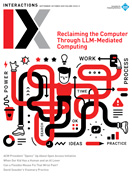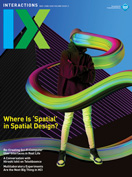Authors:
Jeff Johnson, Douglas Schuler
It was gratifying to read in Interactions last fall (https://bit.ly/3S1z1Vh) that the Participatory Design Conference is still taking place and has become fairly mainstream. As the authors pointed out, however, the conference seems to be experiencing a bit of an existential crisis: Is it primarily an academic conference for professors and students to publish their research, or a forum for computer system design practitioners to share ways to democratize and improve design?
→ The Participatory Design Conference, focusing on research and practice, was founded in 1990 by the Computers in the Workplace project of Computer Professionals for Social Responsibility.
→ Participatory design was originally developed to address issues of power, human rights, and dignity within the field of computing — issues that remain vitally important today.
As two of the organizers of the first conference, PDC '90, we thought it might be useful to describe the conference's origins and the intent of the founders. Spoiler alert: We think the answer to the above question is both.
In the early 1980s, Severo Ornstein, Laura Gould, and other researchers at Xerox Palo Alto Research Center founded Computer Professionals for Social Responsibility. CPSR took its name from Physicians for Social Responsibility, an organization founded in 1979 that focused on the dangers of nuclear war. CPSR, as an organization of computer professionals, initially focused on a related issue: the danger of relying too heavily on computing in warfare. It first did so with the Strategic Computing Initiative to use AI in weapon systems, and then with the Strategic Defense Initiative (SDI)—a proposed "shield" against nuclear attack based on semiautonomous ground- and space-based computer systems and antimissile weapons systems.
Opposing the development and deployment of the SDI remained CPSR's primary focus until the collapse of the Soviet Union in 1991. In the mid-1980s, however, as CPSR's membership grew and chapters formed around the U.S., some members and leaders began exploring other areas in which computer technology could have harmful as well as helpful impacts on society.
One such initiative was the Computers in the Workplace project of CPSR's Palo Alto chapter. The members' concern about the project was that, while computer technology could provide tools to make work easier and more efficient, thoughtless automation could de-skill and eliminate jobs for human workers. Members of the project had learned of an approach to designing computer-based technology that was being used in Scandinavia but was almost nonexistent in the U.S. That approach, which before the conference did not have a name other than "the Scandinavian approach," focused on improving jobs for workers instead of automating work. To achieve that goal, it treated the intended users as codesigners rather than mere interviewees or test participants. In the 1980s such an approach was considered political in the U.S. and more or less forbidden.
We invited Scandinavian designers and developers who had devised and practiced this approach over to the U.S. to show us how it was done. There was no submission or review of academic papers; all of the speakers were invited. Speakers and workshop leaders included Kristen Nygaard, Pelle Ehn, Kari Thoresen, Susanne Bødker, Kaj Grønbaek, and Kim Madsen. Ellen Bravo from the National Association of Working Women, also known as 9to5, and Jonathan Grudin from MCC and Aarhus University, both U.S. advocates of worker-focused design, rounded out the speaker roster. At the end of the first day, a panel of U.S. researchers, chaired by Lucy Suchman, discussed how to apply the Scandinavian approach in the U.S. The panelists were Frank Emspak from the Center for Applied Technology, Joan Greenbaum from LaGuardia Community College and Columbia University, and Harley Shaiken from the University of California, San Diego. The second day consisted mainly of workshops, with a closing plenary talk by Enid Mumford from the University of Manchester, an early pioneer of user involvement in design in the U.K.
PDC '90 brought together a mix of academics and practitioners to teach and learn how to design with users instead of simply for them. A secondary purpose was to explore how to apply participatory methods in the design of off-the-shelf computer applications in addition to the in-house enterprise applications for which the methods were initially used.
This paradigm shift is captured in the introduction to the first event: Participatory design represents a new approach that differs from the traditional one in several respects:
- It rejects the assumption that the goal of computerization is to "automate" the skills of human workers; instead it sees it as an attempt to give workers better tools for doing their jobs.
- It assumes that the users themselves are in the best position to determine how to improve their work and their work life. In doing so, it turns the traditional designer-user relationship on its head, viewing the users as the experts—the ones with the most knowledge about what they do and what they need—and the designers as technical consultants.
- It considers users' perceptions of technology to be at least as important to success as facts, and their feelings about technology equally important to what they can do with it.
- It views computers and computer-based applications not in isolation but rather in the context of a workplace, as processes rather than as products.
At its core, participatory design was intended to address the power asymmetry that often accompanies computerization. While the exponential growth of computerization has altered the circumstances related to computer use—everybody is now a user or at least feels the effects of computerization—the issues of power and of human rights and dignity still remain important. To that end, we salute the inquiry about the future of PD presented by Daria Loi and Raphael Arar that extends its reach by working with nonprofit and public sectors in addition to commercial sectors, and by adding "public design work intended to strengthen legislated consultation processes, and social impact design oriented at reframing complex social policy issues" to its mission.
PDC '90 brought together a mix of academics and practitioners to teach and learn how to design with users instead of simply for them. A secondary purpose was to explore how to apply participatory methods in the design of off-the-shelf computer applications.
And that is why we say the answer to PDC's existential question is that it's a place for both researchers and practitioners.
Jeff Johnson is an adjunct professor of computer science at the University of San Francisco. In the 1980s and 1990s, he served as chair of CPSR and cochair of PDC'90. [email protected]
Douglas Schuler is a professor emeritus at the Evergreen State College, former chair of CPSR and ACM SIGCAS, and currently president of the Public Sphere Project. He and Aki Namioka edited the book Participatory Design, based on the work presented at PDC '90. [email protected]
Copyright 2025 held by owners/authors.
The Digital Library is published by the Association for Computing Machinery. Copyright © 2025 ACM, Inc.








Post Comment
No Comments Found